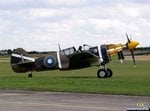The 325FG had two brilliant victories over the Me 109 while equipped with theThe 325FG flew 128 combat missions with the P-40 in the MTO.
Results:
Shot down in air-to-air combat:
96 Me 109
26 MC 202
7 Me 323
3 Ju 52
3 Fi 156
In addition, the 325's P-40s dropped 329,000 lbs. of bombs.
Losses:
17 to enemy fighters
6 to flak
5 to unknown causes (probably weather, fuel or mechanical)
3 to engine failure
2 to mid-air collision
1 to small-arms fire
1 to hitting high tension wires.
P-40. On July 1, 1943, while on a fighter sweep over southern Italy, 22 P-40s
were bounced by 40 Me 109s. Results: one P-40 shot down, 20 Me 109s shot down.
On July 30, 1943, similar situation: 20 P-40s on a fighter sweep over Italy
bounced by 35 Me 109s. One P-40 shot down, 21 Me 109s shot down.
In these two battles, the 109s engaged the P-40s in classic, turning
dogfights--and lost big time. The Curtiss fighter could outmaneuver the German
fighter, take hits that would wreck the Me, and dish out much greater firepower
than the 109. The Me's only clear superiority was in the climb, which was not
helpful. It could not out-turn the P-40s, dive away from them or outrun them.
Nor could it outshoot them or take as much punishment as they could.


